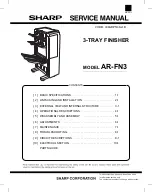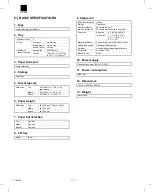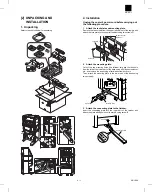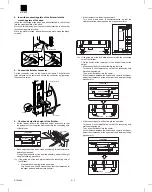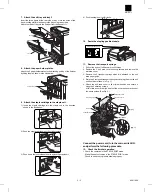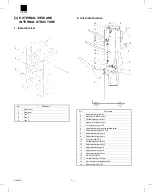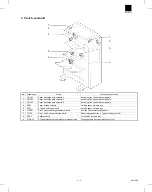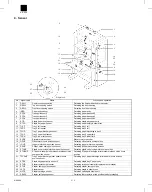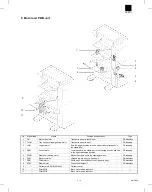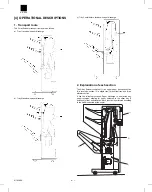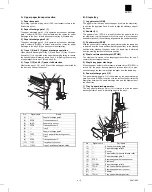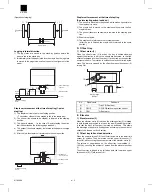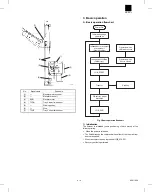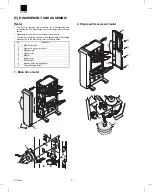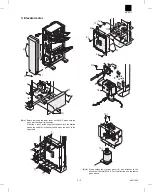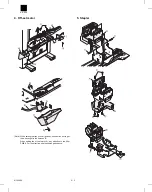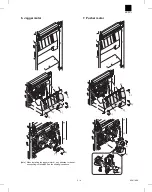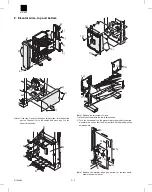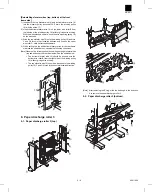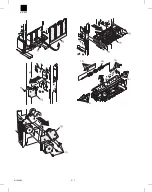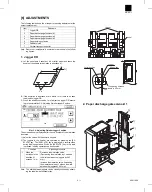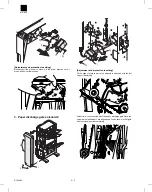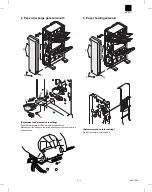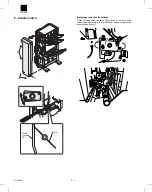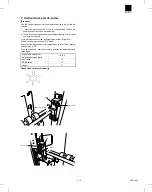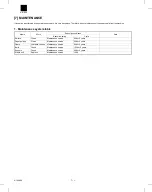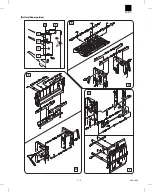
(Operation of stapling)
Jogging in lateral direction
1) The jog plates are moved to the stand-by position before the
paper is fed to the staple tray.
2) Immediately after the paper is fed into the staple tray, the jog plate
is moved to the paper size position to ensure the alignment of the
paper.
Staple unit movement at the time of stapling (1-point
stapling)
1) The stapler unit is moved to the stapling position.
– The number of sheets to be stapled is fed to the staple tray –
2) The pusher (the sheets to be stapled) is lowered to the stapling
position.
3) The paper is stapled ... (in the case of 2-point stapling, the action
that is described on the following page is added.)
4) The pusher (the sheets stapled) is elevated to the paper discharge
position.
5) After the job, the stapler unit is returned to the home position.
Stapler unit movement at the time of stapling
(2-point stapling action is added.)
1) The pusher is elevated to the position which makes it possible for
the staple unit to move.
2) The staple unit is moved to the staple position where the 2nd
staple is driven.
3) The pusher (sheets to be stapled) is lowered to the stapling posi-
tion.
4) Sheets are stapled.
5) The staple unit is returned to the 1st staple position.
(After the job is finished, the staple unit is returned to the home
position.)
D. Off-set tray
1) Off-set motor (3)
When the off-set motor (3) is driven, the tray is shifted sideways
against the direction in which the sheets are delivered, so that the
sheets discharged into the off-set tray (1) are sorted by the specified
number of sheets. The rotation is unidirectional and controlled by the
crank. The motor is stopped by the off-set home position sensor (2)
turning ON.
No.
Signal name
Part name
(1)
—
Tray 3 (Off-set tray)
(2)
OFHP
OFHP Off-set home position sensor
(3)
OFM
Off-set motor
E. Elevator
1) Elevator motor (3)
When the elevator motor (3) is driven, the winding pulley (5) is rotated
in both forward and reverse to wind up the wire (6) stretching vertical-
ly so that the tray 3 (off-set tray) is moved up and down. This allows
the discharge of paper at a fixed position according to the number of
sheets to be loaded on the off-set tray.
2) Off-set tray full and load detection
When the power is turned ON, the off-set tray lowers to the lower limit
sensor (4) position. Then it elevates until the upper limit sensor (7)
turns ON, while counting the encoder pulses of the elevator motor (3).
The volume of paper loaded on the off-set tray is calculated (0 -
100%) by counting the number of pulses from the elevator encoder
(1).
The off-set tray is judged to be full when both the lower and upper
limit sensors (4), (7) are turned ON.
1)
2)
2)
1)
Jog plate
R
Jog plate
F
Pusher
Paper size
5)
1)
3)
2)
4)
Pusher
Staple unit
Home
position
Paper discharge
position
Staple position
ST rail
Staple unit moving
motor
3)
4)
2)
5)
1)
Pusher
Staple unit
moving range
Staple position
ST rail
Staple unit moving
motor
(3)
(2)
(1)
Moving range
(30 mm)
AR-FN3
8/19/1999
4 – 3
Summary of Contents for AR-FN3
Page 20: ...15 15 15 15 16 AR FN3 8 19 1999 5 7 ...
Page 27: ... Rollers Paper guides AR FN3 7 2 8 19 1999 ...
Page 28: ...AR FN3 8 19 1999 7 3 ...
Page 29: ... Gears Others Sensors Belts AR FN3 7 4 8 19 1999 ...
Page 51: ...3 Main PWB page arrangement 1 2 AR FN3 10 9 8 6 1999 ...
Page 52: ...Main PWB page arrangement 2 2 AR FN3 8 6 1999 10 10 ...

